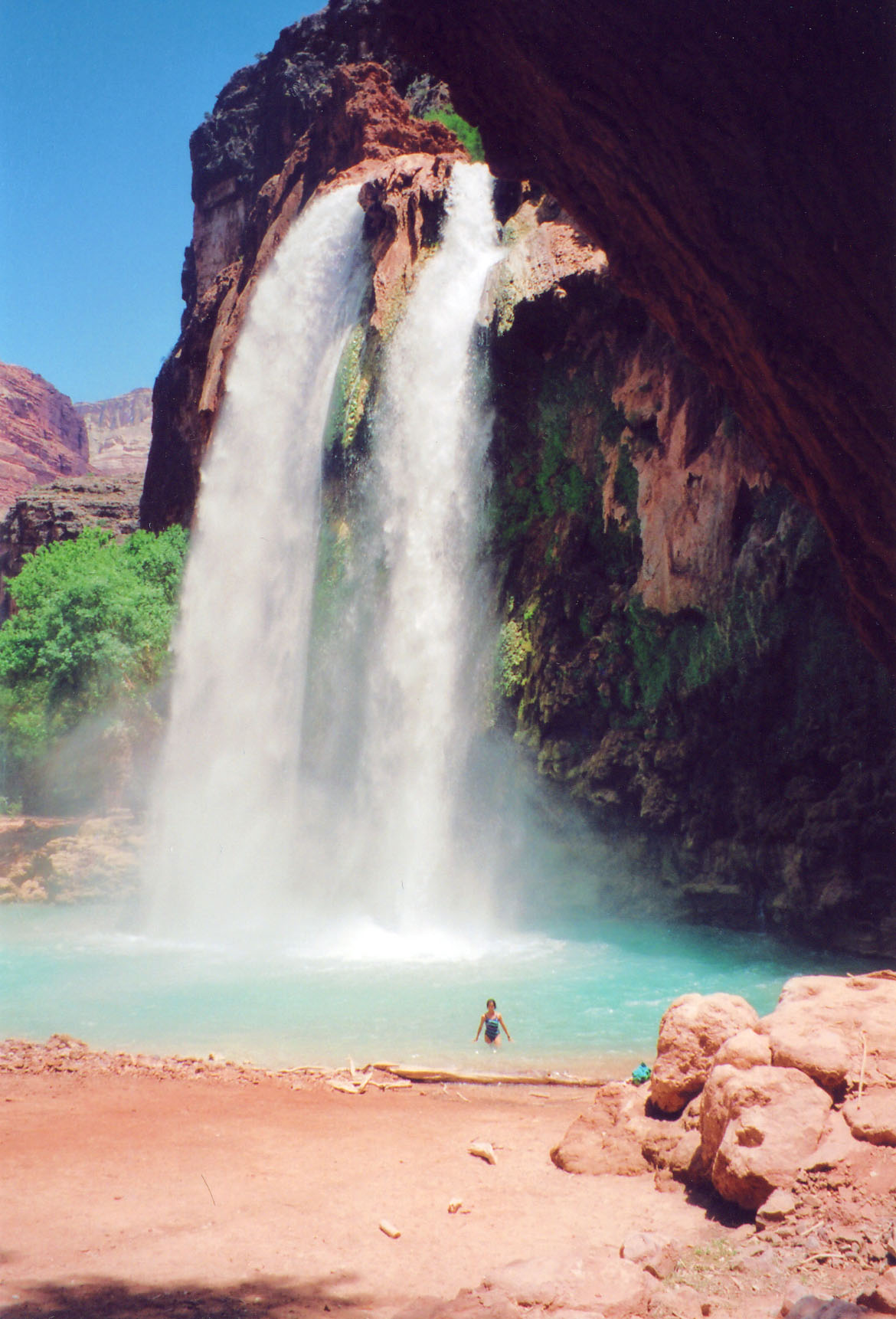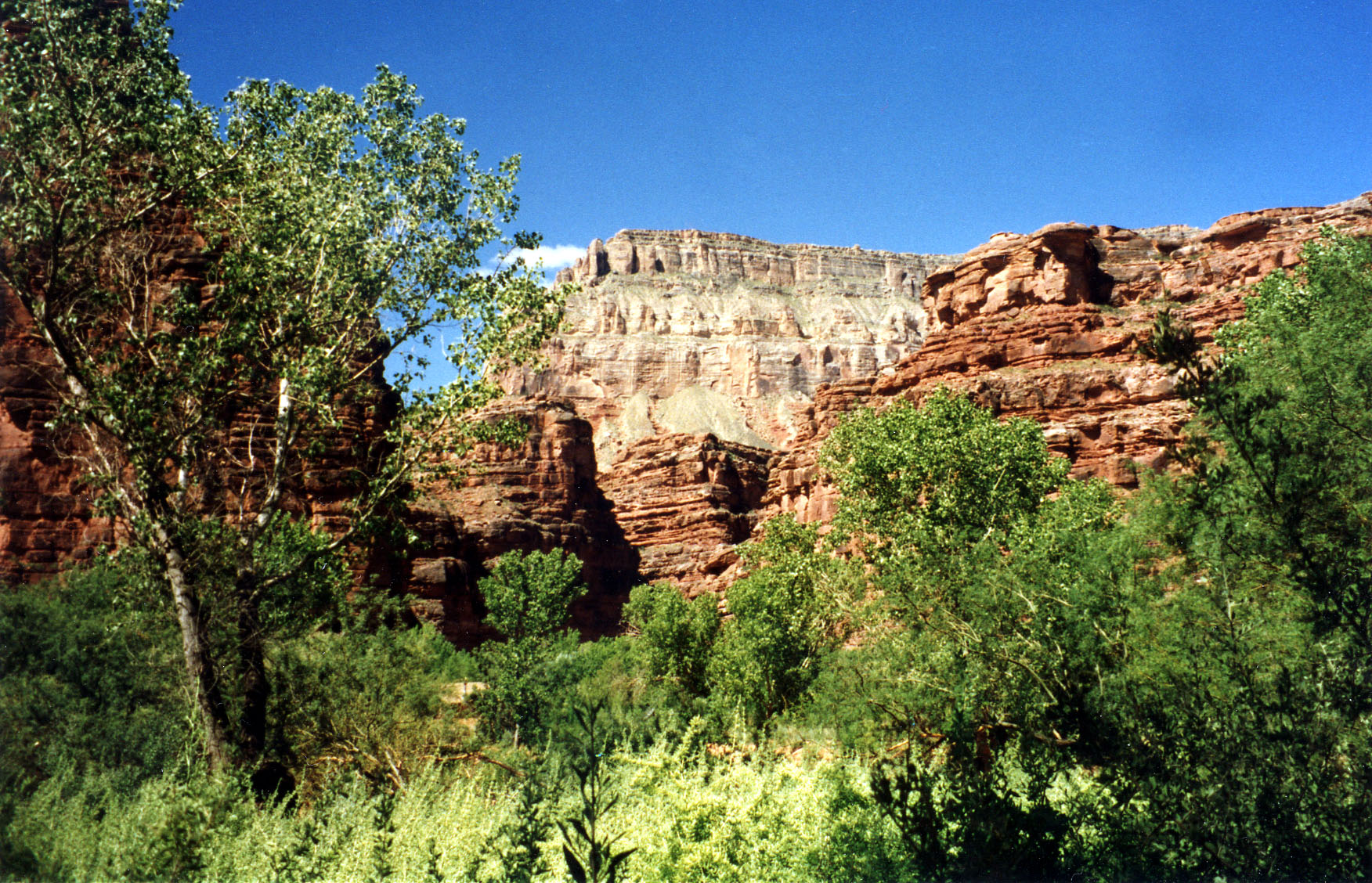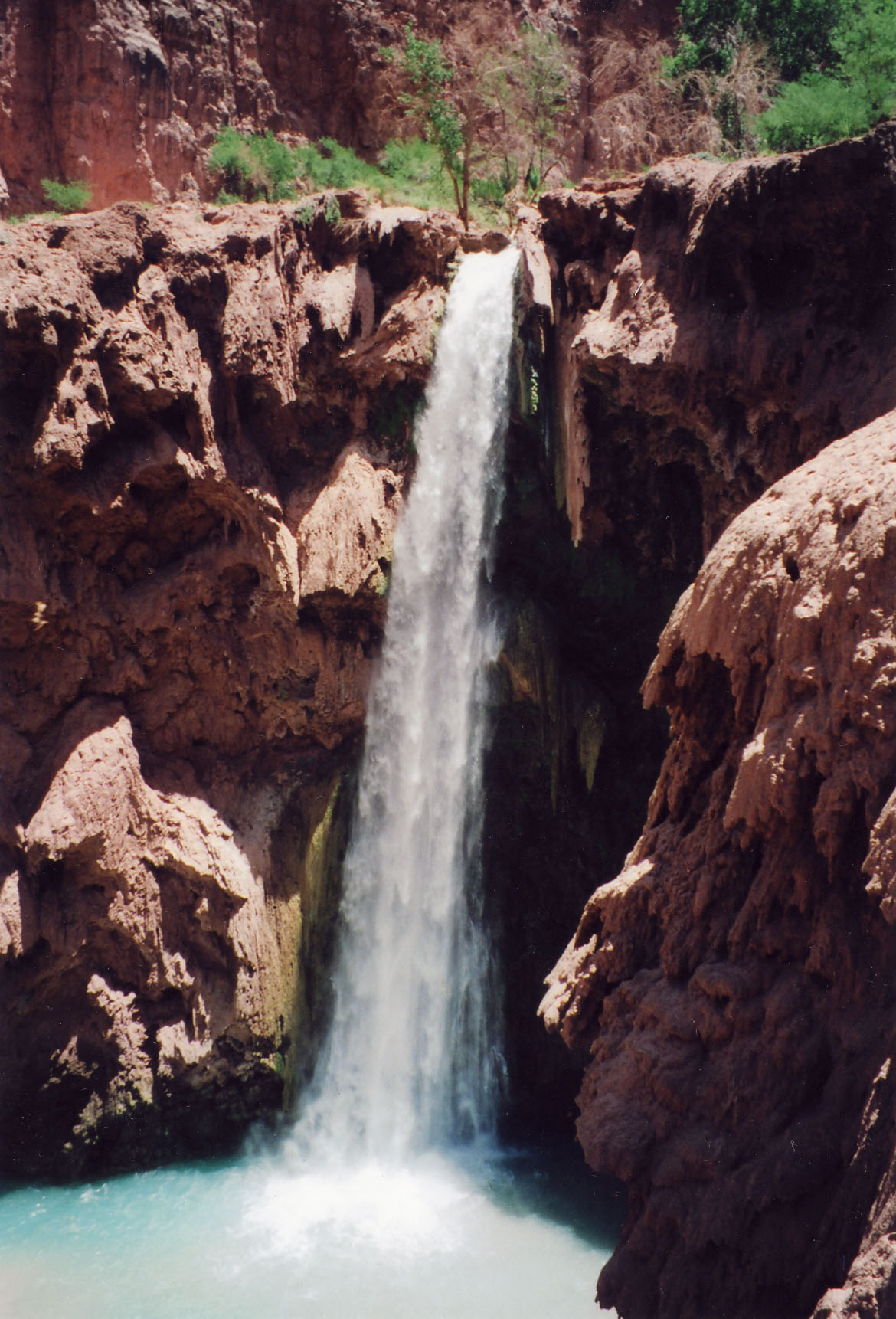

HAVASU CANYON, ARIZONA
Havasu Canyon is a paradisiacal gorge where turquoise waters cascade into travertine pools and graceful willows and lofty cottonwoods provide shade and greenery in an extraordinary setting of towering red sandstone cliffs beneath a cerulean sky. It is a side branch of the Grand Canyon that was once the home of a prehistoric people but more recently it has been the occupied by the Havasupai for the past 800 years.
 |
Havasu Falls |
Seasonal rainfall, melting snow and percolating water are drained by Cataract Creek which rises on Bill Williams Mountain and crosses the Coconino Plateau. The creek wanders across the high plains for about 50 miles before dipping down into the steep sided Cataract Canyon. Except for flash floods, Cataract Creek is usually a mere trickle until it reaches Havasu Springs where an underground river gushes forth to form Havasu Creek. With a steady flow rate of about 28,000 gallons per minute and a heavy concentration of suspended calcium carbonate, the river bed is rapidly lined with limestone that reflects the sunlight and gives the creek its striking blue-green color. The waters plunge over Navajo Falls, Havasu Falls (100ft.), Mooney Falls (200ft.) on the way to the Colorado River about ten miles away from Supai Village.Water is especially precious in a dry and arid land and the Havasupai consider the source of this river to be a sacred place that is intimately associated with the legend of their origin. There are legends, too, of their end for they believe that the Wigleeva, two stone pillars that overlook their village, are guardian spirits and their destruction will signal the demise of the Havasupai.
"Havasupai" means "people of the blue-green waters." The Havasupai tribe is the smallest Indian Nation in America totaling about 600 people. Before the arrival of Europeans, they farmed the land where the canyon widened and the plentiful waters of Havasu Creek allowed them to create an emerald haven in a sun scorched land. In the summertime, they grew corn, squash, melons and beans and after harvesting their crops in the fall, they moved to winter settlements on the rim of the canyon where men hunted deer, antelope and small game and women made beautiful baskets. They traded with the Zuni and Hopi exchanging buck skins and red ocher for pottery and turquoise. The Havasupai were renowned for their fine quality buck skins and their powdered red ocher, obtained from a secret place, was particularly prized by other tribes for painting their faces. This idyllic lifestyle was interrupted by the arrival of miners and ranchers who siezed their lands on the plateau and restricted them to a small reservation in the canyon. Almost a century passed before their winter homelands were restored by Congress in 1975. Today, they continue to cultivate their crops but their tanning and basket weaving skills are known mainly to the older people. They have developed a successful tourist industry which brings the outside world within their sphere. However, some people believe this contact increases their struggle to preserve their unique cultural heritage.
Father Francisco Garces, a Spanish missionary priest was the first European to visit the Havasupai in their canyon in 1776. He found 34 families whom he described as happy and hard working. Among some of the first prospectors to visit the Havasupai in 1879 was an ex-sailor named Mooney who fell to his death descending the waterfall that carries his name. There was also a young prospector named Dahoney who noticed some unusual pictographs on the canyon walls and the remains of an ancient megalithic fortress perched on the rim of a sheer cliff. Dahoney's observations are supported by Frank H. Cushing's description of his encounter with the Havasupai in 1882. He, too, noted red and white pictographs as well as cliff dwellings and masonry storehouses in the cliffs. Authorities believe that the cliff dwellings and storehouses were built by a prehistoric people unrelated to the Havasupai. In 1924, Dahoney sponsored and participated in a scientific expedition to explore the evidence of prehistoric man in the area. Their findings generated more questions than those answered.
 |
Havasu Canyon |
Apparently, the red sandstone contains iron that forms a thin black film on the surface of the rock. By cutting through the black film with a sharp instrument, the red sandstone underneath is exposed creating the pictograph. The expedition identified controversial wall drawings of a dinosaur and several ibex. Dinosaur tracks have been found in the area but it is generally held that dinosaurs were extinct for millions of years before the appearance of man. This painting suggests that Paleo-Indians were either much older than originally thought or some dinosaurs became extinct more recently. Also, ibex have never been found in America. These paintings imply otherwise and even today, they remain an enigma to palaeontologists. The ancient fortress, cliff dwellings and wall paintings are located in other areas of the Havasupai Reservation that are not accessible to visitors but this information contributes to our appreciation of the amazing and timeless phenomenon that is the Grand Canyon complex.
Best Times to Go
April to May and September to November are best for a visit to
Havasu Canyon because the climate is moderate on the rim as well as on the canyon floor.
These months also avoid the heat and crowds of summer.
Getting There
There are no roads to Supai Village so visitors arrive by horse
or on foot. The trail begins at Hualapai Hilltop which is a parking area with no
facilities. Some hikers overnight at Hualapai Hilltop because it is more comfortable to
start the trek in the cool, early morning hours. The nearest towns are Peach Springs and
Seligman which are both located on Highway 66 about 68 and 90 miles respectively from
Hualapai Hilltop. From Highway 66, take Route 18 north for approximately 60 miles to the
trailhead. The sign for Route 18 is obscure, especially in the dark. An early morning
drive across the Coconino Plateau can be rewarding for a glimpse of the stately mule deer
that browse the shrubs in the pre-dawn hours.
The sparse vegetation and dry, rocky soil at the trailhead give no hint of the lush canyon home of the Havasupai at the bottom of Havasu Canyon, 10 miles away. The trail drops steeply by a series of switchbacks into Hualapai Canyon for the first mile and then descends more gradually for a half mile to the bottom of the canyon. Its sheer, massive walls become narrow, blocking the sunlight and distorting the size of giant boulders along the path. Eventually the canyon widens and cottowoods, willows, box elders, hackberry trees and wild grape vines diffuse the harsh sunlight of a mid-morning sun. The path follows a small creek that joins the noisy Havasu Creek at the confluence of the Hualapai and Havasu Canyons. Cattails, maidenhair fern and watercress can be seen along the creek to the village of Supai past peach orchards, fig trees and cultivated fields of corn and alfafa. Campers continue for two more miles to the first campsites.
Clothing/ Gear
Bring comfortable clothing, swim suit, sturdy walking shoes,
brimmed hat, insect repellent, sunblock, camera and lots of film. Ground fires are
prohibited so a gas stove is necessary for those who plan to cook.
General Information
All hikers must obtain advance approval from the Havasupai
Tourist enterprise before starting into the canyon. In additon, advanced reservations and a 50% deposit are required for the lodge and the campground. On arrival at Supai Village, visitors
register and pay an entrance fee. Amenities include campgrounds, a lodge, a village café, a
general store and a post office.
All financial transactions require cash except the Camping Enterprise and the lodge where Mastercard, Visa, travelers checks and money orders are accepted. The entrance fee is $20 per person and the camping fee is $10 per person nightly. Horses are available for rent to carry packs or riders. Contact the Havasupai Tourist Enterprise to determine all costs because they are subject to change and may vary with the season.
Planning Tips
 |
Mooney Falls |
Our Readers Write
Important Resources
The Havasupai Tourist Enterprise approves and organizes visits to
the Havasu Canyon and is responsible for collecting entrance fees, camping fees and
arranging the rental of horses to carry packs or riders. Pit toilets, potable water and
picnic tables are provided at campsites.
Havasupai Lodge accepts room reservations for your stay in Supai
Village. Rooms have double beds, private bath and air conditioning but no television or
telephones. Meals are available at the village café.
The Havasupai Tribal Council reviews applications and requests to
visit other areas of the Havasupai Reservation. However, permission is rarely granted to
the general public and only special circumstances are subject to consideration.
Grand Canyon Caverns Inn is situated along Route 66 about 5 miles
east of Route 18 and 66 miles from Hualapai Hilltop. A restaurant and convenience store
are available but the nearest gas station is located in Peach Springs, 12 miles to the
west.
Route 66 Motel is a clean, modest motel that is located on Route 66 about 90 miles from Hualapai Hilltop and 29 miles to the east of Route 18. Gasoline and basic supplies may be purchased in Seligman and there is a restaurant nearby.
Related Books

Adventures Great and Small © copyright 1996-2005